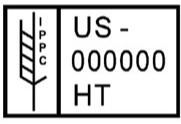The USDA and APHIS have released an official notice to all U.S. Exporters regarding the alteration of certified wood products. Essentially, the notice states that ISPM 15 wooden export crates or pallets that are altered or repaired, must be re-certified by an approved wood packaging material production company.
To avoid unnecessary export delays and possible fines, do not mix wood in or on packaging and distribute this notification to everyone in your organization that may have an interest in the subject.
Valley Box will continue to keep you updated on compliance alerts and are available to answer any questions you have. Check out our other article "Why Do I need Heat Treated Wood?"
Notice to U.S. Exporters: Altering Certified Wood Packaging Materials

The U.S. Department of Agriculture’s Animal and Plant Health Inspection Service (APHIS) reminds U.S. exporters not to alter certified wooden export crates in any way or mix it with other, non-certified materials. Individuals or companies who alter certified wooden export crates and distribute the altered product are not in compliance with APHIS regulations and the “International Standards for Phytosanitary Measures No 15, Guidelines for Regulating Wood Packaging Material in International Trade” (ISPM 15).
United States exporters who use non-compliant materials may be subject to international fees, fines, and possible bans by our trading partners. Repair and re-manufacture companies producing and distributing non-compliant wood packaging material could be held liable by the exporter and/or prosecuted by the U.S. Department of Justice.
APHIS’ wood packaging material regulations took effect in July 2006 and require wooden export crates moving internationally to have an ISPM 15 mark which is legible and easily visible on each piece of packaging; preferably on two opposite sides of the material. To find approved wood packaging material production companies in your area, or to learn how to become an approved company, please contact one of the 19 agencies authorized to perform wood packaging material inspections on behalf of APHIS.
Consult the listing of agencies and their contact information at the Web site of the ACCREDITED AGENCIES FOR SUPERVISORY AND LOT INSPECTION OF WOOD PACKAGING MATERIAL, April 2015, visit the ALSC website and download this pdf. (Please note the locations of these agencies are the company headquarters and may not indicate their areas of service.)
APHIS’ wood packaging material regulations are based on the ISPM 15. ISPM 15 provides effective, equitable, and uniform standards (prescribed treatments, certification procedures, and standardized markings) that all nations could use to mitigate the risk from wood packing material. APHIS incorporated the ISPM 15 requirements into its import and export regulations (7 CFR 319.40-3(b) and 7 CFR 353.7 (d), respectively).
In accordance with these regulations, U.S. Customs and Border Protection inspects imported wood packaging material. American Lumber Standard Committee, through a Memorandum of Understanding with APHIS, inspects U.S.-produced or -reconstituted wood packaging material, using accredited third-party inspection agencies. These inspections keep non-compliant material out of the United States. APHIS is authorized through the Plant Protection Act to take the same legal action against fraudulent stamps as it would against counterfeit phytosanitary certificates. Violations of ISPM 15 requirements under the Plant Protection Act have resulted in a variety of enforcement actions, including an administrative decision and order, civil penalties of as much as $100,000, and felony convictions.
What is ISMP 15
The International Plant Protection Convention (IPPC) has adopted a minimum standard for Wood Packaging Material (WPM), known as the ISPM-15 standard, which is part of this international framework. WPM made of processed wood material, referred to as man-made or engineered lumber, is exempt from compliance with the standard. The ISPM-15 standard requires that WPM be debarked, treated, and marked with the standardized, accepted stamp certifying compliance, as defined further in this section.

Wood packaging materials that are ISMP-15 need to be marked to indicate that is has been treated in accordance with approved phytosanitary procedures. The mark must contain:
- The symbol - The design of the symbol (shown in the left half of the example that follows) should resemble closely the one shown in the example below and be presented to the left of the other components
- Country code -The country code (shown in the example as XX) must be the two-letter International Organization for Standards (ISO) country code
- Producer or treatment provider code - The producer or treatment provider code (shown in the example as 000) identifies the producer of the WPM or the treatment provider who applies the mark. The codes are assigned by the National Plant Protection Organization (NPPO) of the country of WPM production or treatment.
- Treatment code - The treatment code (shown in the example as YY) is an approved abbreviation indicating either heat treatment (HT), dielectric heating (DH), methyl bromide treatment (MB). The code must appear on a separate line from the country code and producer/treatment provider code, or be separated by a hyphen if presented on the same line as the other codes.
- DUN when indication is used for dunnage.




